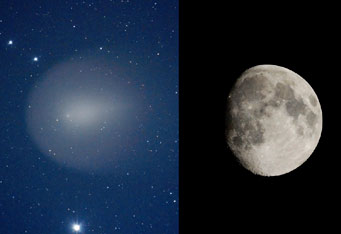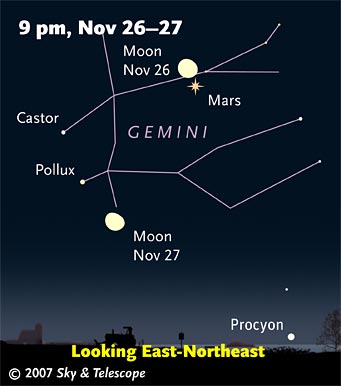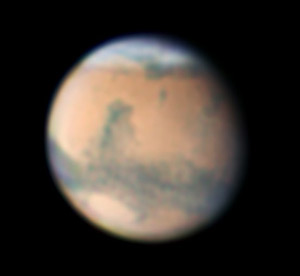Some daily events in the changing sky for November 23 – December 1.

On the evening of November 21st the dimming head of Comet Holmes was about 0.6° wide, just a bit larger than the Moon — as shown in this pair of images that Gary Seronik shot at the same scale. Click image for larger view.
S&T: Gary Seronik
Comet Holmes is fading and tough to spot with the naked eye, as it continues to enlarge and lose surface brightness. But binoculars still give a good view — and a moonless window of dark sky begins to open up after the end of twilight starting on Monday the 26th. The comet is now moving away from 2nd-magnitude Alpha Persei (Mirfak), which is at the bottom of the photo here. See our finder chart, full story, and reader photos.
Friday, November 23
Saturday, November 24
Sunday, November 25

Watch the Moon pass close by Mars late on the night of the 26th. (These scenes are drawn for the middle of North America. European observers: move each Moon symbol a quarter of the way toward the one for the previous date. For clarity, the Moon is shown three times its actual apparent diameter.)
Sky & Telescope diagram
Monday, November 26
Tuesday, November 27
Wednesday, November 28
Thursday, November 29
Friday, November 30
Saturday, December 1
Want to become a better amateur astronomer? Learn your way around the constellations. They're the key to locating everything fainter and deeper to hunt with binoculars or a telescope. For an easy-to-use constellation guide covering the whole evening sky, use the big monthly foldout map in each issue of Sky & Telescope, the essential magazine of astronomy. Or download our free Getting Started in Astronomy booklet (which only has bimonthly maps).
Once you get a telescope, to put it to good use you'll need a detailed, large-scale sky atlas (set of maps; the standard is Sky Atlas 2000.0) and good deep-sky guidebooks (such as Sky Atlas 2000.0 Companion by Strong and Sinnott, the even more detailed Night Sky Observer's Guide by Kepple and Sanner, or the enchanting though increasingly dated Burnham's Celestial Handbook). Read how to use them effectively.
More beginners' tips: "How to Start Right in Astronomy".
This Week's Planet Roundup
Mercury is now disappearing into the glow of sunrise. During its recent fine morning apparition, John Boudreau of Saugus, Massachusetts, shot perhaps the best amateur imagery of Mercury we've ever seen, showing light and dark markings that remained consistent across many days.
Venus (magnitude –4.3, in Virgo) is the bright "Morning Star" blazing in the southeast before and during dawn. Spica, much dimmer, shines below it early in the week, and lower right of it by November's end.

Syrtis Major juts upward in this image of Mars taken by S&T's Sean Walker on the morning of November 19th. The huge North Polar Hood of clouds was thin enough that surface features showed through. And note the bright haze filling the Hellas Basin, near the limb at the 7 o'clock position. Mars was 14 arcseconds wide, and the central-meridian longitude was 269°. Walker used a 12.5-inch reflector, a DMK 21AF04.AS camera, and CS RGB color filters.
S&T: Sean Walker
Mars, shining brightly at magnitude –1.2 in the middle of Gemini, now rises as early as 7 p.m. and is up in fine view by 10. It shines very high in the early-morning hours — passing near the zenith, in fact, for mid-northern observers (around 2 or 3 a.m.).
In a telescope Mars now appears 14.5 to 15 arcseconds in diameter, nearly as wide as the 15.9" it will display around its Christmas-season opposition. For all about observing Mars with a telescope this season, see the guide and surface-feature map in the November Sky & Telescope, page 66.
Jupiter (magnitude –1.8) is disappearing into the sunset, just above the southwest horizon in twilight.
Saturn (magnitude +0.7) rises around midnight and is very high in the south before and during dawn. Fainter Regulus (magnitude +1.4) is 8° to Saturn's upper right after they rise, and directly right of it as they fade out in the light of dawn.
Uranus (magnitude 5.8, in Aquarius) is well placed in the south right after dark, high above Fomalhaut.
Neptune (magnitude 7.9, in Capricornus) is getting lower in the south-southwest. Finder charts for Uranus and Neptune are in the July Sky & Telescope, page 60, and online.
All descriptions that relate to your horizon or zenith — including the words up, down, right, and left — are written for the world's midnorthern latitudes. Descriptions that also depend on longitude (mainly Moon positions) are for North America. Eastern Standard Time (EST) equals Universal Time (UT, UTC, or GMT) minus 5 hours.
To be sure you always get the current Sky at a Glance, bookmark this URL:
http://SkyandTelescope.com/observing/ataglance?1=1
 0
0
Comments
You must be logged in to post a comment.